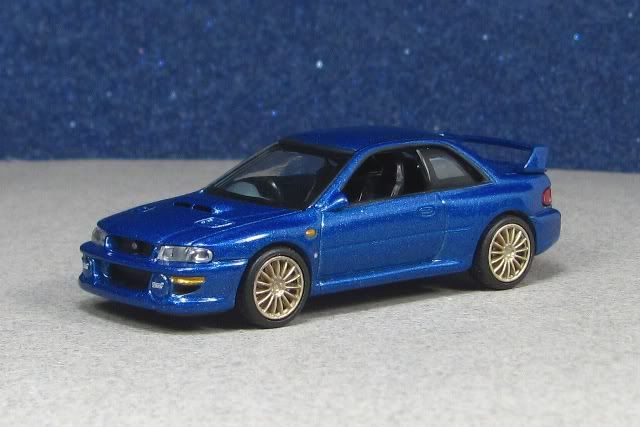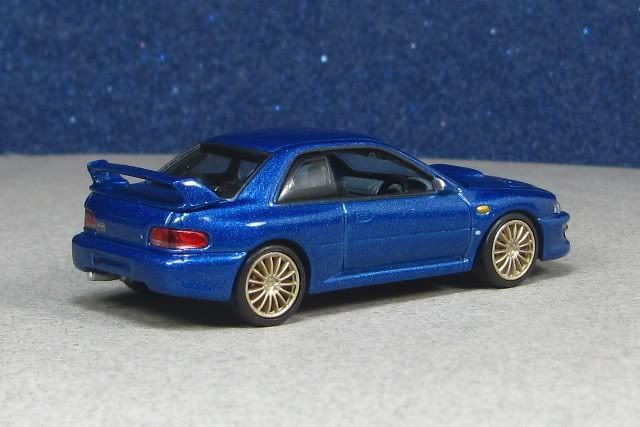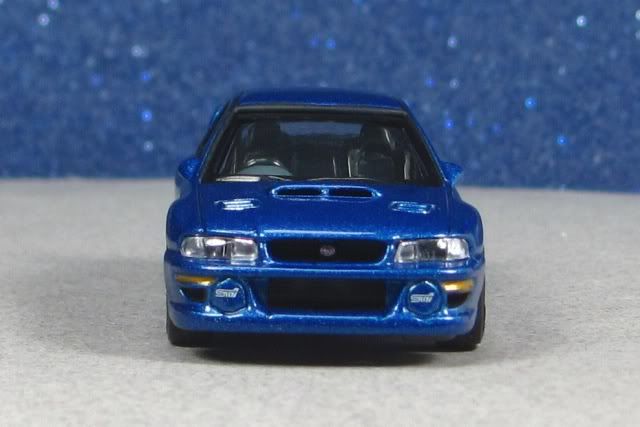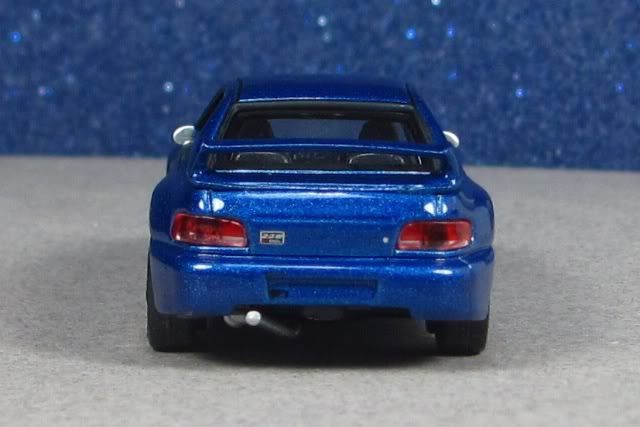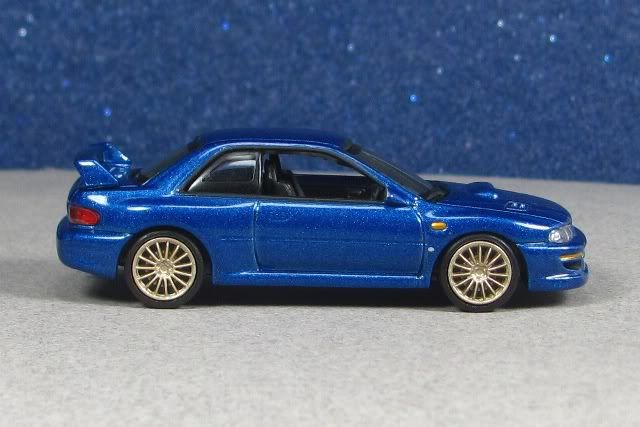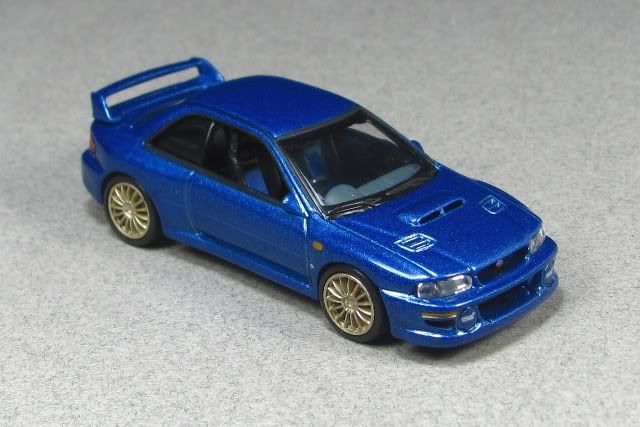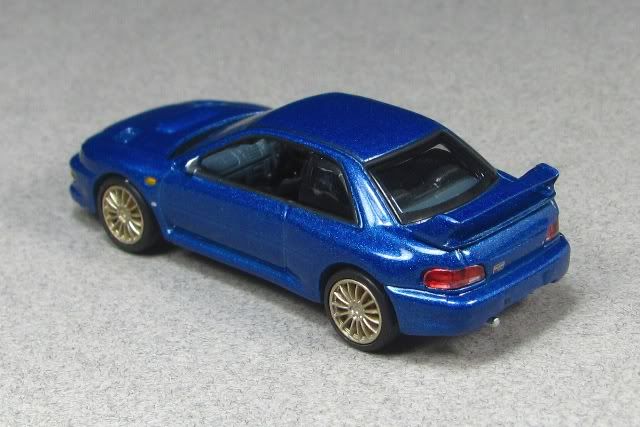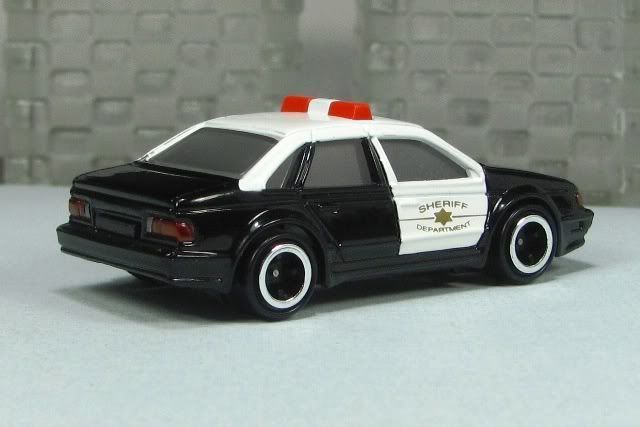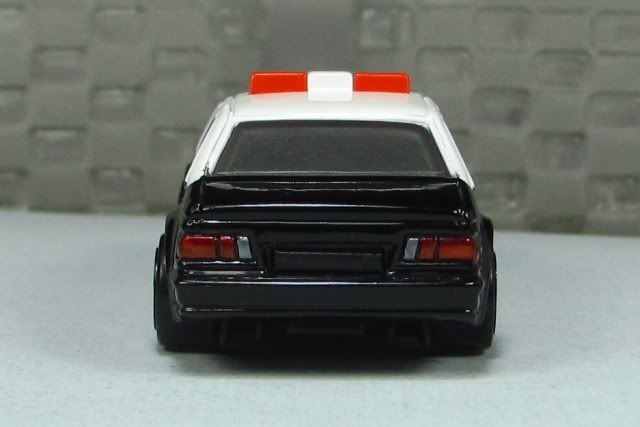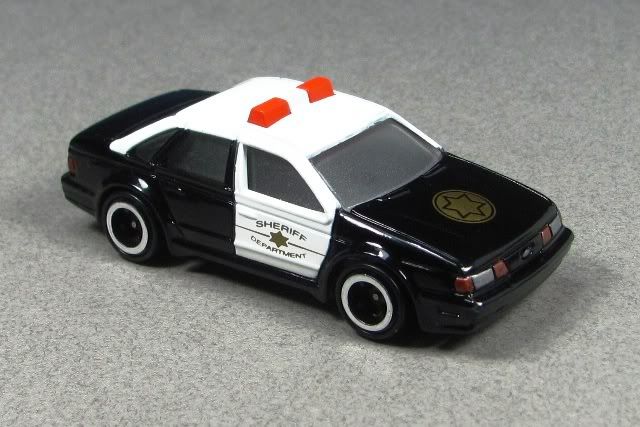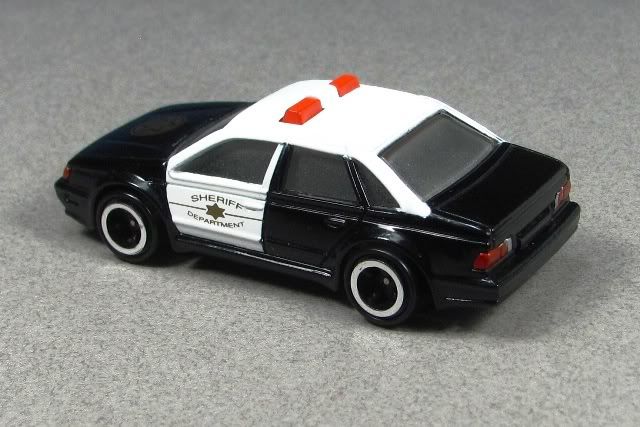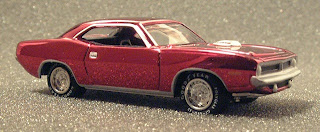
A blog focusing on 1/64 diecast from such popular brands as Hot Wheels, Matchbox, Johnny Lightning, M2 Machines, GreenLight, Tomica, Yat Ming, Majorette, MotorMax, Siku, Corgi, Guisval, Playart, Ertl, Zylmex, Racing Champions, & many more. Swifty's Garage features a daily Car Of The Day and news updates from your favorite brands!
Thursday, August 23, 2012
Car Of The Day: August 23, 2012
Today's car of the day comes from Dean-O-mite's collection and is MicroChamps' 1993 Ford Escort RS Cosworth.
The Ford Escort RS Cosworth was a sports derivative of the Ford Escort. It was designed to qualify as a Group A car for the World Rally Championship, in which it competed between 1993 and 1998. It was available as a road car from 1992-96 in very limited numbers. It was instantly recognizable due to its large "whale tail" rear spoiler. The main selling point was the Cosworth YBT engine, a highly tunable turbocharged 2-litre engine which had an output of 217 hp in standard trim. It was also widely acknowledged to have excellent handling.
For more information and pictures of the real car please visit: Ford Escort RS Cosworth
This is a recent addition to my collection, thanks to JustDavid. This had long been on my most-wanted list, and David spotted it at the Albuquerque gathering, and picked it up for me. (THANKS AGAIN, DAVID!)
MicroChamps was the brand name the MiniChamps parent company decided to give their first venture into the small-scale market. The MicroChamps name is cast into the base. It is a very nice casting, at 1/64 scale.
Ford developed the car around the chassis and mechanicals of its predecessor, the Sierra Cosworth to accommodate the larger Cosworth engine and transmission, whilst clothing it in Escort body panels to make it resemble the standard Mk V. The Escort Cosworth was a rare car, with 7,145 vehicles produced from the start of production on 19 February 1992 until the last car rolled out of the factory on 12 January 1996. A tiny number were unofficially imported to the United States, where it was considered one of the greatest performance Fords of all time.
The initial cars included features that, although they made the Cosworth a more effective car, did not enhance it as a road vehicle, and once the rules were satisfied Ford attempted to make the car less temperamental and easier to drive under normal conditions. The second generation, starting production from late 1994, were fitted with a Garrett T25 turbocharger, a smaller unit which reduced turbo lag and increased usability in everyday driving situations. With these later models, the 'whale tail' spoiler became a delete option.
Wednesday, August 22, 2012
Car Of The Day: August 22, 2012
Today's truck of the day comes from Dean-O-mite's collection and is Pioneer's 1996 Kenworth T2000 Tow Truck.
Kenworth is an American manufacturer of medium and heavy-duty Class 8 trucks based in Kirkland, Washington, United States, a suburb of Seattle, Washington. It is a subsidiary of PACCAR, and is also a former manufacturer of transit buses and school buses. Kenworth began its history in Portland, Oregon. In 1912, the company was founded by brothers George T. and Louis Gerlinger, Jr. as a car and truck dealership known as Gerlinger Motor Car Works. In 1914, they decided to build their own truck with a more powerful inline six-cylinder engine. This was the first ever put into a commercial truck. The Gersix, as it was known, unveiled in 1915, was framed in structural steel, which along with its power, made the truck ideal for the rugged Northwest, where it was used for logging. In 1916 the Gerlinger Motor Car Company moved to Tacoma, Washington. Seattle businessman Edgar K. Worthington was managing his mother's commercial building, where Gerlinger became a tenant, and became intrigued by the Gerlinger company. Worthington's tenant was doing quite well, or so it seemed, and the Gersix became a popular fixture in the Northwest. In 1917 Worthington and his business partner Captain Frederick Kent bought the Gerlinger business, renaming it the Gersix Motor Co. In 1919 Kent retired from the business, and his son Harry Kent became Worthington's new partner. In 1922, Gersix made 53 trucks at its factory on Fairview Avenue at Valley Street. Trucks and motor coaches were assembled in individual bays rather than on a conventional assembly line. In 1923 Kent and Worthington reincorporated the business as the Kenworth Motor Truck Company. The name was a combination of the two names "Ken" and "Worth", ironically the same as the surname "Kenworth." In 1926 they started making buses, and in 1933 Kenworth was the first American company to offer diesel engines as standard in their trucks. In 1945 Kenworth was bought by The Pacific Car and Foundry Company.
For more information and pictures of the real car please visit: Kenworth
Although not a licensed model, this Pioneer is a decent miniature of the Kenworth T2000. Pioneer makes cheap diecast, typically sold in multi-pack sets. For a sub-one-dollar toy, this one is made pretty nicely. I especially appreciate the amber light bar, combined with the clear windows; two different pieces of plastic, where a lot of companies would have just done it all in one color.
There is no page on Wikipedia for the T2000. Only the page for Kenworth as a company has any mention of the T2000. Doing my own digging, I got some helpful information from ehow.com, on their 'Commercial Truck Fuel Economy' page: The T2000 was introduced in May of 1996, as a 1996 model. The T2000 remained in production through 2010. The T2000 was replaced by the T700. The T2000's claim to fame was its aerodynamics and subsequent fuel economy. At the time of its introduction, typical average fuel economy for a truck pulling a loaded trailer was about 5.5mpg. The average fuel economy for a T2000 pulling a loaded trailer was about 7.0mpg.
While an average of 7 mpg (the economy of a Kenworth T2000 on flat land) might seem unimpressive by some standards, it's absolutely amazing when compared to the average automobile. The important thing to bear in mind is that most tractor trailers get that 7 mpg while hauling 40,000+ pounds of freight, for a combined truck/freight total of 80,000 pounds; that's one gallon of fuel burned per mile at 11,428 pounds. By comparison, an average 4,500 pound SUV would have to get 124 mpg to see the same fuel/weight efficiency.
Tuesday, August 21, 2012
Car Of The Day: August 21, 2012
The Chevrolet Vega is a subcompact automobile that was produced by the Chevrolet division of General Motors from 1970 to 1977. Named after the brightest star in the constellation Lyra, it came in two-door hatchback, notchback, wagon, and panel delivery body styles, all powered by an inline four-cylinder engine with a lightweight, aluminum alloy cylinder block. The Vega received praise and awards at its introduction, including Motor Trend Car of the Year. Subsequently the car was known for a wide range of problems related to its engineering, reliability, safety, propensity to rust, and engine durability. Despite a series of recalls and design upgrades, the Vega's problems tarnished both its own as well as General Motors' reputation. Production ended with the 1977 model year.
For more information and pictures of the real car please visit: Chevrolet Vega
Lindberg is better known for their larger plastic model kits, but they also had a series of small-scale Mini-Lindy models, which like their larger siblings, were also sold as unassembled plastic model kits. The assembly process for the small-scale models was quite simple, not requiring any real model building skills. Lindberg's small-scale models were produced in the late 1960's and 1970's, as well as a short-lived attempt to enter the market again in 1990, with a few of the original Lindberg castings, mixed with a few new castings of modern cars, molded in bright colored plastics with gray trim instead of chromed pieces.
The wheelbase on all models is 97.0 inches. 1971 and 1972 models are 169.7 inches long. 1973 models are 3 inches longer due to the front 5 mph bumper. Front and rear 5 mph bumpers on 1974 to 1977 models add another 5.7 inches. The Hatchback Coupe with its lower roofline and a fold-down rear seat accounted for nearly half of all Vegas sold. The Sedan was later named the Notchback. The Panel Express panel delivery model had steel in place of the wagon's rear side glass, an enclosed storage area under the load floor, and low-back seats for driver and passenger (optional) without headrests.
The Vega was designed for vertical shipment, nose down. General Motors and Southern Pacific designed "Vert-A-Pac" Railroad cars to hold 30 Vegas each, compared with normal tri-level autoracks which held 18. The Vega was fitted with four removable cast-steel sockets on the underside and had plastic spacers, removed at unloading, to protect engine and transmission mounts. The rail car ramp/doors were opened and closed via forklift. Vibration and low-speed crash tests ensured the cars would not shift or suffer damage in transit. The Vega was delivered topped with fluids, ready to drive to dealerships, so the engine was baffled to prevent oil entering the number one cylinder; the battery filler caps high on the rear edge of the casing prevented acid spills; a tube drained fuel from carburetor to vapor canister; and the windshield washer bottle stood at 45 degrees.
Monday, August 20, 2012
Car of the Day:August 20, 2012
Today's car of the day is Carisma's 1996 Subaru Impreza WRX STI V-Limited Coupe.
The Subaru Impreza is a compact automobile, manufactured since 1992 by Subaru, the automobile division of Japanese transportation conglomerate, Fuji Heavy Industries (FHI). Subaru introduced the Impreza as a replacement for the Leone / Loyale. Now in its fourth generation, Subaru has offered four-door sedan and five-door hatchback body variants since 1992; the firm also offered a coupe from 1995 for the first generation only. Mainstream versions have received naturally aspirated "boxer" flat-four engines ranging from 1.5- to 2.5-liters, with the performance-oriented Impreza WRX and WRX STI models uprated with the addition of turbochargers.
For more information and pictures of the real car please visit: http://en.wikipedia.org/wiki/Subaru_Impreza
The name is almost as impressive as the diecast. Subaru Impreza WRX STI V-Limited Coupe. This true 1/64 scale model features a metal base, simulated rubber tires, two-tone interior, and plastic lenses for the headlights and tail lights. The blue paint and blue seat inserts indicate this model represents the V-Limited edition of the Impreza WRX STI. Carisma was a small Japanese diecast company, which only produced two models (this Impreza and a Mitsubishi Lancer Evolution sedan). Both models have excellent detailing and build quality. Carisma later became the brand Auto Rozza (unknown if just a name change, or a change of ownership), and a newer generation Impreza was produced under the new name, before Auto Rozza also disappeared from small-scale.
Introduced in November 1993, the Impreza was offered in either front-wheel drive (FWD) or all-wheel drive (AWD) versions and as a four-door sedan or five-door hatchback. In late 1995, a two-door coupe was introduced. In 1994, Subaru introduced Subaru Tecnica International (STI) versions of the Impreza WRX in Japan. These models were upgraded from the standard WRX in many categories, including blueprinted performance-tuned engines, transmissions, and suspensions. The STI versions of the Impreza were immensely successful in rallies and popular among street racers but were only sold in the Japanese market. Compared to the WRX, the STI had mostly mechanical modifications.
The 1996 model year WRX debuted in January 1996. The WRX design received minimal mechanical changes, but a WRX V-Limited Edition was introduced to celebrate the success of the Impreza WRC car in the FIA WRC. The V-limited cars are painted in World Rally Blue. A WRX STI V-limited edition was also produced. The interior is colored blue on the seat inserts and carpeting. 1,000 WRX STI Version 2 V-limited were produced.
Sunday, August 19, 2012
Car of the Day:August 19, 2012
Today's police car of the day is Ertl's 1989 Ford Taurus SHO.
Wikipedia.com
The Ford Taurus SHO (Super High Output) is a performance sedan based on the Ford Taurus that was originally produced by the Ford Motor Company from 1989 until 1999. It returned in 2009 for the 2010 model year.
The SHO (originally spoken as individual letters, as of 2010, pronounced "show") was built by the same team that produced the Ford Mustang SVO. It was originally created as a limited production model for 1989 through 1993. However, the car proved to be very popular and quickly sold its planned 15,519 units in its first model year, leading Ford to order more engines and begin series production. The SHO would go on to be produced for ten years in three generations, totaling 106,465 vehicles as of late 1999.
For more information and pictures of the real car please visit: http://en.wikipedia.org/wiki/Ford_Taurus_SHO
This Taurus SHO was released in the "Speed Strips" series, by Ertl. Each Speed Strips car has a multi-picture comic strip inside, and each came with a small viewer, which clipped into the base of the car and the user could rotate through each picture in sequence. Although the novelty was fairly unique, so was Ertl's decision to cast a Taurus SHO. Matchbox's Sable comes close, but no other first-generation Taurus (SHO, or not) exists in small-scale at this time. The Speed Strips series only yielded one release for each casting, so this police version was the only paint scheme available on the car. Eat your heart out, Robocop!
The SHO differed from the normal Taurus on the exterior by having different bumpers, side cladding, and fog lamps. The interior also differed, with sports seats and an 8000 rpm tachometer. The SHO became the only Taurus to feature a manual transmission since the 4-cylinder MT-5 was discontinued in that year.
The first generation Taurus SHO can accelerate from 0-60 mph in 6.6 seconds with a quarter mile time of 15.0-15.2 seconds. Car and Driver reported in their December 1989 issue a top speed of 143 mph.
Saturday, August 18, 2012
Car of the Day:August 18, 2012
The car for today is the Welly 1957 Chevrolet Corvette.
Wikipedia.com
The Chevrolet Corvette (C1) is the first generation of the sports car by the Chevrolet division of General Motors introduced late in the 1953 model year and produced through 1962. It is commonly referred to as the "solid-axle" generation, as the independent rear suspension didn't appear until the 1963 Sting Ray. The Corvette was rushed into production for its debut model year to capitalize on the enthusiastic public reaction to the concept vehicle, but expectations for the new model were largely unfulfilled. Reviews were mixed and sales fell far short of expectations through the car's early years. The program was nearly canceled, but Chevrolet would ultimately stay the course and Harley Earl and company would transform the Corvette into a true world-class sports car.
For more information and pictures of the real car, please visit: http://en.wikipedia.org/wiki/Chevrolet_Corvette_%28C1%29
Wikipedia.com
There was no doubt Chevrolet was in the sports car business with the release of the 1956 model. It featured a new body, a much better convertible top with power assist optional, real glass roll up windows (also with optional power assist), and an optional hardtop. The 3-speed manual transmission was standard. The Powerglide automatic was optional. The six-cylinder engine was gone. The V8 remained at 265 cubic inches but power ranged from 210 hp to 240 hp. The volume was 3,167, a low number by any contemporary standard and still less than 1954's 3,640, meaning this was the third lowest-volume model in Corvette history.
Visually the 1957 model was a near-twin to 1956. Engine displacement increased to 283 cu in, fuel injection became optional, and a 4-speed manual transmissionwas available after April 9, 1957. Fuel injection first saw regular use on a gasoline engine two years prior on the Mercedes-Benz 300SL "gullwing" roadster. Although the Corvette's GM-Rochester injection used a constant flow system, as opposed to the diesel style nozzle metering system of the Mercedes', the Corvette's engine nevertheless produced about 290 hp (gross). This was underrated by Chevrolet's advertising agency for the 283 hp 283 small-block V8 one hp per in³ slogan, making it one of the first mass-produced engines in history to reach 1 hp/cu in. Pushed toward high-performance and racing, principally by Zora Arkus-Duntov who had raced in Europe, 1957 Corvettes could be ordered ready-to-race with special options. Fuel injection was in short supply and 1,040 Corvettes with this option were sold.
Friday, August 17, 2012
Car Of The Day: August 17, 2012
Today's car of the day comes from juantoo3's collection and is Johnny Lightning's 1970 Plymouth Barracuda.
The Plymouth Barracuda is a two-door car that was manufactured by the Plymouth division of the Chrysler Corporation from 1964–1974.
The first-generation Barracuda, a fastback A-body coupe based on the Plymouth Valiant, had a distinctive wraparound back glass and was available from 1964–1966.
The second-generation 1967–1969 Barracuda, though still Valiant-based, was heavily redesigned. Second-generation A-body cars were available in fastback, notchback, and convertible versions.
The 1970–1974 E-body Barracuda, no longer Valiant-based, was available as a coupe and a convertible, both of which were very different from the previous models. The final model year for the Barracuda was 1974.
For more information and pictures of the real car please visit: Plymouth Barracuda
Since Paul had a bunch of Christmas issues offered, I just assumed this one was another. Well, you know what they say about not assuming anything...
What a pleasant surprise to find out this is a MoPar Muscle First Shot! And I asked for it just because it had a drop dead gorgeous candy apple chrome paint! I've always liked the old B body Mopars, even if I like the Challenger just a bit better, I sure wouldn't look away from a 'Cuda! -Wes (juantoo3)
The redesign for the 1970 Barracuda removed all its previous commonality with the Valiant. The original fastback design was deleted from the line and the Barracuda now consisted of coupe and convertible models. The all-new model, styled by John E. Herlitz, was built on a shorter, wider version of Chrysler's existing B platform, called the E-body. Sharing this platform was also the newly launched Dodge Challenger; however, no sheet metal interchanged between the two cars and the Challenger, at 110 inches, had a 2 in (51 mm) longer wheelbase than the Barracuda, at 108 inches.
The E-body Barracuda was now "able to shake the stigma of 'economy car'." Three versions were offered for 1970 and 1971: the base Barracuda (BH), the luxury oriented Gran Coupe (BP), and the sport model 'Cuda (BS). In 1971 only, there also was a low-end model called the Barracuda Coupe, which (like other Coupe series Chrysler Corp. had in 1971) had a fixed rear passenger window and minor B pillar instead of roll-down rear passenger windows. The high-performance models were marketed as 'Cuda deriving from the 1969 option. The E-body's engine bay was larger than that of the previous A-body, facilitating the release of Chrysler's 426 cu in (7.0 L) Hemi for the regular retail market.
For 1970 and 1971, the Barracuda and Barracuda Gran Coupe had two six-cylinder engines available — a new 198 cu in (3.2 L) version of the slant-6, and the 225 — as well as three different V8s: the 318ci, the 383ci with 2-barrel carburetor and single exhaust, and the 383ci with 4-barrel carburetor and dual exhaust 330 hp (250 kW) SAE gross. The Cuda had the 383ci 335 hp (250 kW) SAE gross (same as Dodge's 383 Magnum) as the standard engine. It also had the 440ci 4-barrel Super Commando, the 440ci 6-barrel Super Commando Six Pak, and the 426ci Hemi. The 440- and Hemi-equipped cars received upgraded suspension components and structural reinforcements to help transfer the power to the road.
Other Barracuda options included decal sets, hood modifications, and some unusual "high impact" colors such as "Vitamin C", "In-Violet", "Sassy Grass Green" and "Moulin Rouge".
Swede Savage and Dan Gurney raced identical factory-sponsored AAR (All American Racers) 'Cudas in the 1970 Trans-Am Series. The cars qualified for three pole positions but did not win any Trans-Am races; the highest finish was 2nd at Road America.
A street version of the AAR 'Cuda was produced, powered by the 340 cu in (5.6 L) "Six Pack" (three two-barrel carburetors) engine.
The Barracuda was changed slightly for 1971, with a new grille and taillights, seat, and trim differences. This would be the only year that the Barracuda would have four headlights, and also the only year of the fender "gills" on the 'Cuda model.
The 1971 Barracuda engine options would remain the same as that of the 1970 model, except the 4-barrel carbureted 440 V8 engine was not available; all 440-powered Barracudas had a six-barrel carburetor setup instead.
Thus, in 1970 the big-block power options offered to the customer were 1) approximately 270 hp (200 kW) SAE net in the high performance 383-4V, 2) approximately 310 hp (230 kW) SAE net in the 440-4V and 3) approximately 335 hp (250 kW) SAE net in the 440-6V. In 1971 the big-block power options offered to the customer were 1) 250 hp (190 kW) SAE net in the 383-4V and 2) 330 hp (250 kW) SAE net in the 440-6V.
The 426 Hemi remained available with 350 hp (260 kW) SAE net, and the 1971 HemiCuda convertible is now considered one of the most valuable collectible muscle cars. Only eleven were built, seven of which were sold domestically, and examples of these cars have sold for US$2 million.
In 1970 and 1971, the shaker hood and the Spicer-built Dana 60 rear axle were available. The shaker hood was available with 340, 383, 440 4-barrel and 440 6-barrel, and 426 Hemi engines. The heavy-duty (and heavy) Dana 60, with a 9.75 in (248 mm) ring gear, was standard equipment with manual transmissions and 440 6-barrel and 426 Hemi engines, and was optional on those with the automatic transmission.
With a new grille and single headlights (very similar to the 1970 model) and four circular taillights for 1972, the Barracuda would remain basically unchanged through 1974, with new body side stripes, and minor changes to the bumpers to conform with federal impact standards being the only significant variations. Big Block engines (383, 440, & 426 Hemi), heavy duty suspensions and rear axles, and large (15" x 7") tires and wheels were no longer offered. Additionally; convenience/comfort items such as power seats, power windows, and interior upgrade (leather seats and plush carpeting) options were dropped, though a sun roof could still be ordered. For 1972 only, three engine choices were offered: a 225 six, the 318 (base engine for both 'Cuda and Barracuda) and a detuned to meet emission standards 340. For 1973 the 225 six was dropped, with the 318 and 340 V-8's being the only engine choices. For 1974 a slightly more powerful 360 V-8 replaced the 340, and the only real performance options retained were the 4-speed manual transmission (equipped with a Hurst shifter) mated to a performance ratio (3.55 to 1) rear axle for the 340 and 360 engine, giving the car a respectable (for the time) 0-60 time of 8.2 seconds.
As with other American vehicles of the time, there was a progressive decrease in the Barracuda's performance. To meet increasingly stringent safety and exhaust emission regulations, big-block engine options were discontinued. The remaining engines were detuned year by year to reduce exhaust emissions, which also reduced their power output. There was also an increase in weight as bumpers became larger, and starting in 1970, all E body doors were equipped with heavy steel side-impact protection beams. Higher fuel prices and performance-car insurance surcharges deterred many buyers as the interest in high performance cars waned. Sales had dropped dramatically after 1970, and while 1973 showed a sales uptick, Barracuda production ended 1 April 1974, 10 years to the day after it had begun.
Thursday, August 16, 2012
Panel Of The Day: August 16, 2012
Today's car of the day comes from juantoo3's collection and is Matchbox's 1921 Ford Model T delivery van.
The Ford Model T (colloquially known as the Tin Lizzie, T‑Model Ford, 'Model T Ford', or T) is an automobile that was produced by Henry Ford's Ford Motor Company from September 1908 to October 1927. It is generally regarded as the first affordable automobile, the car that opened travel to the common middle-class American; some of this was because of Ford's innovations, including assembly line production instead of individual hand crafting. The Ford Model T was named the world's most influential car of the 20th century in an international poll.
The Model T set 1908 as the historic year that the automobile became popular. The first production Model T was produced on August 12, 1908 and left the factory on September 27, 1908, at the Piquette Plant in Detroit, Michigan. On May 26, 1927, Henry Ford watched the 15 millionth Model T Ford roll off the assembly line at his factory in Highland Park, Michigan.
There were several cars produced or prototyped by Henry Ford from the founding of the company in 1903 until the Model T came along. Although he started with the Model A, there were not 19 production models (A through T); some were only prototypes. The production model immediately before the Model T was the Model S, an upgraded version of the company's largest success to that point, the Model N. The follow-up was the Ford Model A (rather than any Model U). Company publicity said this was because the new car was such a departure from the old that Henry wanted to start all over again with the letter A.
The Model T was the first automobile mass produced on moving assembly lines with completely interchangeable parts, marketed to the middle class. Henry Ford said of the vehicle:
"I will build a car for the great multitude. It will be large enough for the family, but small enough for the individual to run and care for. It will be constructed of the best materials, by the best men to be hired, after the simplest designs that modern engineering can devise. But it will be so low in price that no man making a good salary will be unable to own one – and enjoy with his family the blessing of hours of pleasure in God's great open spaces."
For more information and pictures of the real car please visit: Ford Model T
This one is from a set of cars I picked up recently from a seller in England who bought a large lot of promotional samples from a former employee, thank you Andrew at Little Wheels. Much like Color Comp of New Jersey, Ad Trucks of Norfolk England would use Matchbox castings to create Code 2 promotional items on contract for use as promotional items for various businesses. Of the ten items I purchased, this is my favorite for the 1930s car pictured on the side.
The Ford Model T car was designed by Childe Harold Wills and Hungarian immigrants, Joseph A. Galamb and Eugene Farkas. Henry Love, C. J. Smith, Gus Degner and Peter E. Martin were also part of the team. Production of the Model T began in the third quarter of 1908. Collectors today sometimes classify Model Ts by build years and refer to these as "model years", thus labeling the first Model Ts as 1909 models. This is a retroactive classification scheme; the concept of model years as we conceive it today did not exist at the time. The nominal model designation was "Model T", although design revisions did occur during the car's two decades of production.
Early Ts had a brass radiator and headlights. The horn and numerous small parts were also brass. Many of the early cars were open-bodied touring cars and runabouts, these being cheaper to make than closed cars. Prior to the 1911 model year (when front doors were added to the touring model), US - made open cars did not have an opening door for the driver. Later models included closed cars (introduced in 1915), sedans, coupes, and trucks. The chassis was available so trucks could be built to suit. Ford also developed some truck bodies for this chassis, designated the Model TT. The headlights were originally acetylene lamps made of brass (commonly using Prest-O-Lite tanks), but eventually the car gained electric lights after 1910, initially powered from the magneto until the electrical system was upgraded to a battery, generator, and starter motor, when lighting power was switched to the battery source.
The Model T production system, the epitome of Fordism, is famous for representing the rigidity of early mass production systems that were wildly successful at achieving efficiency but that could accommodate changes in product design only with great difficulty and resistance. The story is more complicated; there were few major, publicly visible changes throughout the life of the model, but there were many smaller changes. Most were driven by design for manufacturability considerations, but styling and new features also played more of a role than commonly realized. In fact, one of the problems for the company regarding design changes was the T's reputation for not changing and being "already correct", which Henry Ford enjoyed and which was a selling point for many customers, which made it risky to admit any changes actually were happening. (The idea of simply refining a design without making radical visible changes would resurface, and score even greater production success, with the VW Type 1.)
The Ford Model TT is a truck made by the Ford Motor Company. It was rated at one ton. It was based on the Ford Model T, but with a heavier frame and rear axle. The rear axle had a worm drive and crown wheel, unlike the Ford Model T's Crown wheel and pinion. The worm was located at the end of the driveshaft and above the crown wheel. The wheelbase of the car was 100 inches (2,500 mm) and the wheelbase of the TT was 125 inches (3,200 mm). It was often equipped with a 'ruckstell axle' or some other accessory gearbox which allowed the truck to have an intermediate gear between low and high, which was useful for hill climbing. It was often sold as a chassis with the buyer supplying the truck body as needed. Mass production with Ford produced bodies ran from 1925 to 1927, but production of the Ford TT had started with the first TT chassis being released in 1917. In 1923, it cost $380. In 1925, a hand operated windshield wiper was added.
It was very durable for the time, but slow when compared to other trucks. With standard gearing, a speed of not more than 15 mph (24 km/h). was recommended, and with special gearing, a speed of not more than 22 mph (35 km/h) was recommended, according to Ford Dealers Data Book 1923. Standard worm gear ratio was 7.25:1, special gearing 5.17:1. Because of this, accessory catalogs offered items to help give the Model TT more power.
Subscribe to:
Posts (Atom)






















